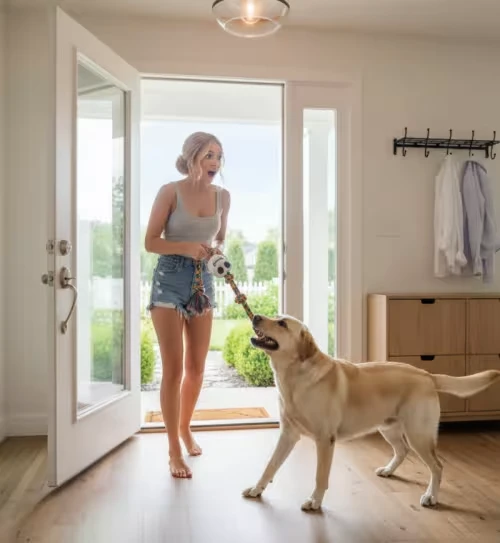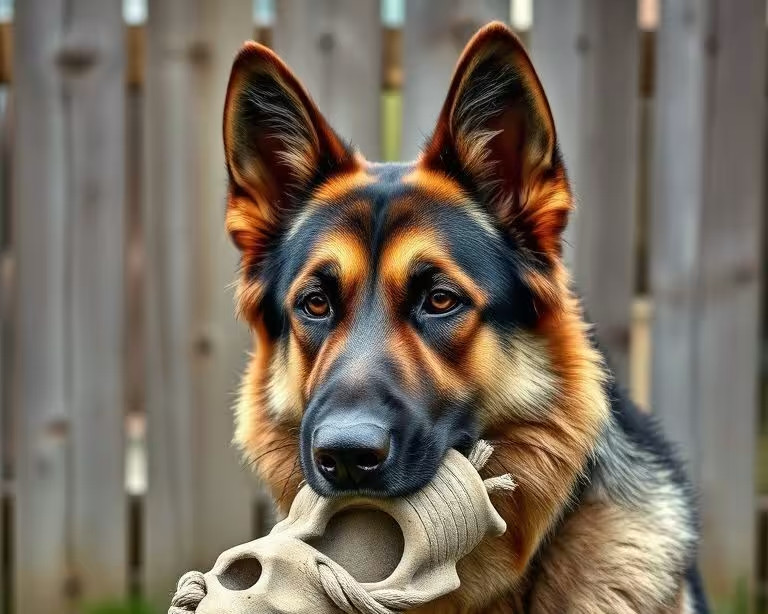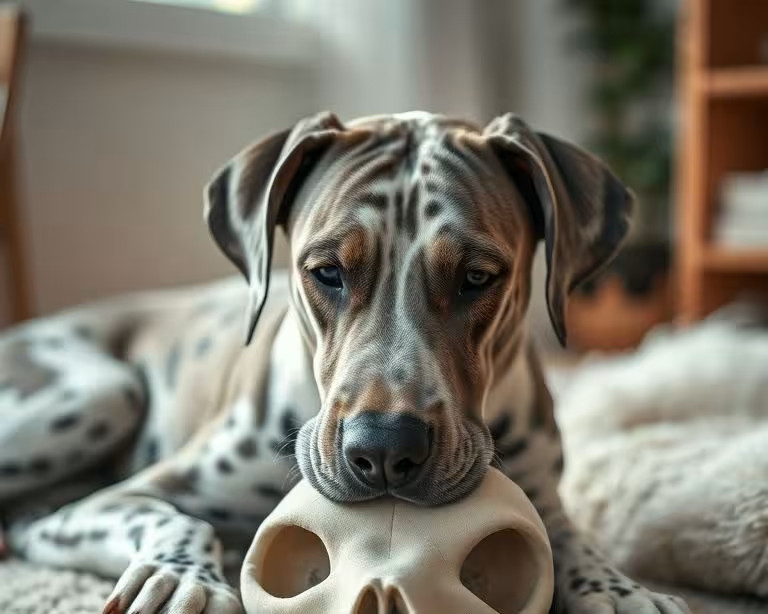Conquer Boredom & Anxiety: The Ultimate Guide to Interactive Dog Toys, Featuring Skull Designs with Rope

Does your furry friend spend their days chewing on furniture, digging holes in the garden, or exhibiting signs of anxiety? The solution might lie in providing them with engaging and stimulating toys. This comprehensive guide explores the world of interactive dog toys, focusing on designs that address boredom, relieve anxiety, and satisfy even the most aggressive chewers. We'll delve into innovative options like skull-design chew toys with embedded ropes, examining their benefits and how they cater to different needs.
Understanding Your Dog's Needs: The Foundation for Choosing the Right Toy
Before diving into specific toys, understanding your dog's personality and chewing habits is crucial. A playful Golden Retriever puppy will have different needs than a powerful German Shepherd known for its strong bite. Consider these factors:
Chewing Style: From Gentle Nibblers to Power Chewers
Is your dog a light chewer, a moderate chewer, or an aggressive chewer who destroys everything in their path? Aggressive chewers require extra durable toys made from tough materials like natural rubber, reinforced nylon, or even extremely tough rope. Light chewers might prefer softer textures, while moderate chewers benefit from a balance of durability and comfort. Identifying your dog's chewing style is the first step to preventing frustration and ensuring toy longevity.
Breed and Size: Safety and Appropriateness in Toy Selection
A small dog like a Chihuahua needs smaller toys than a Great Dane. Consider the toy's size and weight to ensure it's safe and appropriate for your dog's breed and size. A toy that's too small can be a choking hazard, while one that's too large might be cumbersome and uninteresting. Always follow manufacturer guidelines for sizing and breed suitability.
Activity Level: Matching Toys to Energy Output
A high-energy dog needs toys that provide constant mental and physical stimulation. Interactive puzzle toys and toys that encourage fetch or tug-of-war are excellent choices. A less active dog might prefer a more relaxed chewing toy that helps relieve stress, such as a long-lasting chew or a comfort-providing plush toy. The goal is to provide an outlet for their energy that aligns with their natural inclinations.
Anxiety Levels: Toys as a Soothing Mechanism
Does your dog suffer from separation anxiety, fear, or general anxiety? Certain toys can help alleviate anxiety by providing comfort and a sense of security. Some toys offer soothing textures and scents that can calm your dog down, while others provide mental distraction through puzzle-solving. Understanding their anxiety triggers can help you select the most effective calming toy.
Skull Design with Rope to Keep Them Busy: A Unique Approach to Canine Enrichment
One innovative design gaining popularity is the skull-shaped chew toy with embedded rope. These toys combine the satisfying texture of rope with a unique, visually appealing design. The skull shape might seem unusual, but it offers several benefits:

- Novelty: The unique shape piques a dog's interest, making it more engaging than traditional chew toys. This novelty is particularly important for dogs who quickly become bored with their toys, offering a fresh challenge and prolonged engagement.
- Durability: Many skull chew toys are made from tough, durable materials capable of withstanding even the most aggressive chewing. The integrated rope, often braided or tightly woven, adds another layer of durability and provides a varied, long-lasting chewing experience.
- Mental and Physical Stimulation: The embedded rope allows for satisfying tugging and chewing, providing both physical exertion and mental engagement. This combination is especially beneficial for dogs prone to boredom or destructive behavior, channeling their instincts positively.
- Variety: Skull-shaped toys come in different sizes, materials (e.g., natural rubber, hardened nylon), and rope thicknesses, allowing you to find the perfect match for your dog's needs and chewing style. Some even include squeakers or other interactive elements to add to the fun.

Choosing the Right Skull Chew Toy for Maximum Engagement and Safety
When selecting a skull-design chew toy, look for these qualities to ensure both fun and safety:
- Durable, Non-Toxic Materials: Opt for toys made from high-quality, non-toxic materials like natural rubber, food-grade nylon, or sturdy cotton rope that can withstand rigorous chewing. Always check the manufacturer's specifications for details about the materials used and certifications.
- Secure Construction: Ensure the rope is securely attached to the skull, preventing any potential choking hazards. Avoid toys with loose threads, easily detachable parts, or areas where small pieces could be torn off. The integrity of the toy is paramount.
- Appropriate Size: Choose a size that is appropriate for your dog's breed and size to avoid choking or accidental ingestion. A toy that is too small can be swallowed, while one too large might not be easily manipulated.
- Regular Inspection and Replacement: Always inspect the toy for damage after each use. Look for cracks, tears, loose rope strands, or worn-down areas. Replace it as soon as it shows significant wear and tear to prevent your dog from ingesting broken pieces.
Dog Chew Toys for Aggressive Chewers: The Ultimate Test of Durability
Aggressive chewers require toys that can stand up to their powerful jaws and determined chewing habits. These dogs often destroy ordinary toys in minutes, leading to frustration for both the dog and the owner, and potentially costly damage to furniture and other household items. Selecting the right toy is crucial for their satisfaction and your peace of mind.
Top Durable Toy Types for Power Chewers
- Kong Toys: Kongs are legendary for their durability and ability to withstand even the most intense chewing. Their unique, unpredictable bounce adds an element of mental stimulation, and they can be stuffed with treats to provide prolonged engagement, making them challenging and rewarding.
- Nylabones: Nylabones are another popular choice, specifically designed for aggressive chewers. They are made from tough, virgin nylon material and are engineered to withstand significant chewing. They often come in various shapes, textures, and flavors that dogs find appealing, helping to clean teeth as they chew.
- Durable Rubber Toys: Many durable rubber toys are specifically designed for aggressive chewers. Look for toys made from thick, high-quality, natural rubber that is resistant to tearing and punctures. Examples include extreme-duty rubber balls, rings, and other shapes that offer a satisfying give without breaking down quickly.
- Wooden Chew Toys (Select Varieties): Certain types of dense, naturally hard wooden chew toys, such as those made from coffee wood or olive wood, can withstand heavy chewing. However, always supervise your dog closely when using a wooden chew toy to ensure they don't splinter or break off into smaller, potentially hazardous pieces. Avoid softer woods.
Safety Precautions for Aggressive Chewers: Prioritizing Your Dog's Well-being
- Constant Supervision: Always supervise your dog when they are playing with a chew toy, especially if they are an aggressive chewer. This allows you to intervene immediately if the toy begins to break apart or poses a choking risk.
- Frequent Inspection: Check the toy frequently—before, during, and after use—for any signs of damage. If it shows any cracks, tears, missing pieces, or significant wear and tear, replace it immediately. A damaged toy can become a hazard.
- Toy Rotation: Keep a variety of chew toys available and rotate them regularly. This not only keeps your dog engaged and prevents boredom but also allows you to inspect toys thoroughly between uses and prolongs their lifespan.
Interactive Dog Toys for Anxiety Relief: Calming the Nervous System with Play
Many dogs suffer from anxiety, which can manifest in various ways, including excessive barking, destructive chewing, restlessness, pacing, or even aggression. Interactive toys can be a valuable tool in managing your dog's anxiety by providing distraction, mental engagement, and a sense of security. The key is to find toys that provide comfort, mental stimulation, and a positive outlet for their nervous energy.
Effective Toy Types for Anxious Dogs
- Puzzle Toys: Puzzle toys challenge your dog's mind, requiring them to solve a problem to receive a treat. This mental engagement provides a sense of accomplishment, reducing boredom and stress by redirecting anxious energy into focused activity. Look for varying difficulty levels to keep your dog challenged.
- Lick Mats and Treat Dispensers: Lick mats, often made of silicone with textured surfaces, are designed to hold spreadable treats like peanut butter or yogurt. The act of repetitive licking is incredibly soothing for anxious dogs, releasing endorphins that promote relaxation. Treat dispensers that slowly release kibble or treats also provide a calming, prolonged activity.
- Soothing Toys: Some toys are specifically designed with calming textures or scents. For example, toys made from ultra-soft plush materials can provide comfort, similar to a security blanket. Others might be infused with dog-safe essential oils like lavender (always confirm safety with your vet before using essential oils near pets) to help soothe your dog and reduce anxiety.
- Interactive Plush Toys: These combine the comfort of a traditional plush toy with interactive elements, like hidden squeakers, crinkly materials, or pockets for treats. They can keep your dog entertained and distracted from anxiety triggers while offering a soft, comforting companion.

Using Toys for Anxiety Relief Effectively: Best Practices
- Introduce Gradually: Introduce new toys slowly to avoid overwhelming your anxious dog. Let them explore the toy at their own pace, perhaps in a calm, familiar environment.
- Positive Reinforcement: Pair the toy with positive experiences, such as favorite treats, praise, and gentle petting. This will create a positive association with the toy and help reduce anxiety, making the toy a source of comfort rather than another new stimulus.
- Consistency: Offer the toy regularly, especially in situations that typically trigger your dog's anxiety, such as before you leave the house or during thunderstorms. Consistency helps them associate the toy with comfort during stressful times.
- Consult a Vet or Behaviorist: If your dog's anxiety is severe or persistent, always consult your veterinarian or a certified veterinary behaviorist. While toys are a great tool, they are part of a broader management plan that may include training, medication, or other therapeutic approaches.
Beyond the Basics: Advanced Strategies for Canine Enrichment
To truly combat boredom and enhance your dog's well-being, consider integrating advanced enrichment strategies:
- Toy Rotation Schedule: Don't leave all toys out all the time. Rotate toys daily or weekly to keep them fresh and exciting. This prevents 'toy fatigue' and maintains novelty, making each toy seem new again.
- Scent Work and Foraging: Utilize toys that can hide treats or encourage sniffing. Hiding treats around the house or in specialized foraging toys taps into your dog's natural instinct to hunt and sniff, providing immense mental stimulation and satisfaction.
- DIY Enrichment: Simple household items can be transformed into engaging toys. A cardboard box with crumpled paper and scattered treats, or a frozen towel with kibble, can provide low-cost, high-value entertainment. Always ensure DIY toys are safe and non-toxic.
- Training with Toys: Incorporate toys into training sessions. Use a favorite tug toy as a reward for successful commands, or teach your dog to 'find' specific toys by name. This strengthens your bond and provides mental challenges.
The Data-Driven Approach: Comparing Interactive Toy Solutions for Optimal Canine Happiness
Choosing the perfect toy means understanding how different types perform across key metrics. While individual product specifications vary, here's a comparative look at popular interactive toy types, including the innovative skull design with rope:
| Toy Type | Durability Rating | Mental Stimulation | Physical Activity | Anxiety Relief Potential | Key Materials | Pros & Cons |
|---|---|---|---|---|---|---|
| Skull Design with Rope | High (for aggressive chewers) | High (chewing, tugging, novelty) | Tugging, Chewing | Moderate (distraction, engagement) | Natural Rubber, Reinforced Nylon, Cotton/Jute Rope | Pros: Unique aesthetic, dual-texture appeal, excellent for tuggers & chewers, good durability blend. Cons: Rope might fray over time, less suitable for very light chewers. |
| Classic Kong (Extreme/Black) | Very High (for power chewers) | High (puzzle solving, treat dispensing) | Chewing, Fetch (unpredictable bounce) | High (prolonged engagement, licking when stuffed) | Natural Rubber | Pros: Virtually indestructible, great for stuffing, unpredictable bounce for play, excellent for separation anxiety. Cons: Requires owner preparation (stuffing), can be messy. |
| Nylabone (DuraChew) | High (for aggressive chewers) | Low-Moderate (long-lasting chew) | Chewing | Moderate (stress relief through chewing) | Nylon | Pros: Very durable, helps clean teeth, often flavored, long-lasting. Cons: Not for ingesting, some dogs find them less engaging than interactive toys, can be hard on gums if chewed too aggressively. |
| Lick Mat | Variable (low durability if chewed) | Low-Moderate (sensory engagement) | Licking | Very High (endorphin release through licking) | Silicone, Rubber | Pros: Excellent for anxiety relief, soothing, slows down eating, easy to clean. Cons: Not a chew toy, must be supervised, requires spreadable treats. |
| Interactive Puzzle Toy | Variable (depending on material) | Very High (problem-solving, mental challenge) | Nudging, Pushing | High (distraction, mental fatigue) | Plastic, Wood, Rubber | Pros: Maximizes mental stimulation, great for smart dogs, prevents boredom. Cons: Can be expensive, some dogs learn solutions quickly, not always durable for chewers. |
The 'Skull Design with Rope to Keep Them Busy' stands out by offering a fantastic blend of durability, physical play (tug), and mental engagement through its unique design and dual textures. It bridges the gap between a pure chew toy and a highly interactive one, making it a versatile choice for many dogs, especially those who love to tug and chew.
Frequently Asked Questions (FAQ) about Dog Toys
How often should I replace dog toys?
The frequency depends heavily on the toy's material, your dog's chewing habits, and the condition of the toy. Durable toys for aggressive chewers might last months, while soft plush toys might need replacement after a few days or weeks. Always inspect toys daily for damage (tears, loose pieces, splinters, exposed stuffing) and replace them immediately if they show signs of significant wear or breakage to prevent choking hazards or ingestion of harmful materials.
Are all ropes safe for dogs?
While rope toys can be great for tugging and chewing, not all are equally safe. Avoid loosely woven ropes that can easily fray, as ingested strands can cause intestinal blockages. Look for tightly woven, thick ropes made from natural, non-toxic fibers. Always supervise your dog with rope toys, and discard them if they start to unravel or if your dog is actively ingesting strands.
Can toys truly reduce anxiety in dogs?
Yes, interactive and soothing toys can significantly help manage mild to moderate anxiety in dogs. Toys provide distraction from anxiety triggers, offer a positive outlet for nervous energy, and stimulate the mind, which can be calming. Lick mats, puzzle toys, and comfort-scented toys are particularly effective. However, for severe or persistent anxiety, toys should be part of a larger treatment plan developed with a veterinarian or certified behaviorist.
What's the best way to clean dog toys?
Most rubber and hard plastic toys can be washed with warm, soapy water (using mild, pet-safe soap) and thoroughly rinsed, or even placed on the top rack of a dishwasher. Plush toys can often be machine-washed on a gentle cycle in a laundry bag with pet-safe detergent and air-dried. Always check manufacturer instructions. Regular cleaning removes dirt, slobber, and bacteria, promoting better hygiene for your dog.
How do I introduce a new toy to my dog to ensure they like it?
Introduce new toys in a positive, calm environment. Let your dog sniff and explore the toy without pressure. You can make it more appealing by rubbing treats on it, putting it in their food bowl, or playing with it yourself to show them it's fun. If it's a puzzle toy, start with easy settings to build confidence. Positive reinforcement (praise, treats) when they engage with the toy helps create a positive association.
Are scented toys safe for dogs?
Scented toys can be safe if the scents are natural, dog-safe, and used in moderation. Avoid toys with strong artificial fragrances. Natural scents like lavender (known for its calming properties) can be infused into some toys, but always ensure the essential oils used are diluted properly and confirmed safe for canine exposure by a veterinarian. Always supervise initial use.
What materials should I avoid in dog toys?
Avoid toys made from materials that can splinter easily (like some cheap woods or brittle plastics), contain small parts that can be chewed off and swallowed (e.g., plastic eyes on plush toys), or are made with toxic chemicals or dyes. Steer clear of raw rawhide if your dog tends to swallow large pieces, as it can be a choking hazard. Always prioritize non-toxic, durable, and appropriately sized toys.
Conclusion: Tailoring the Perfect Playtime Experience for a Happier, Healthier Dog
Choosing the right dog toy is not just about providing entertainment; it's about meeting your dog's individual needs and enriching their lives. By understanding your dog's chewing style, activity level, and anxiety level, you can select toys that address their specific needs, promoting both physical and mental well-being. The innovative skull design with rope offers a compelling solution, blending unique engagement with robust durability, making it an excellent addition to any dog's toy collection.
Remember, a happy, stimulated dog is a well-adjusted dog. Invest in a range of interactive toys – including those unique skull designs with rope – and watch your dog thrive! Prioritize safety, observe your dog's interaction with toys, and adapt your choices as their needs evolve. Your furry companion deserves the best playtime experience possible.

 By
By
No comments yet. Be the first!